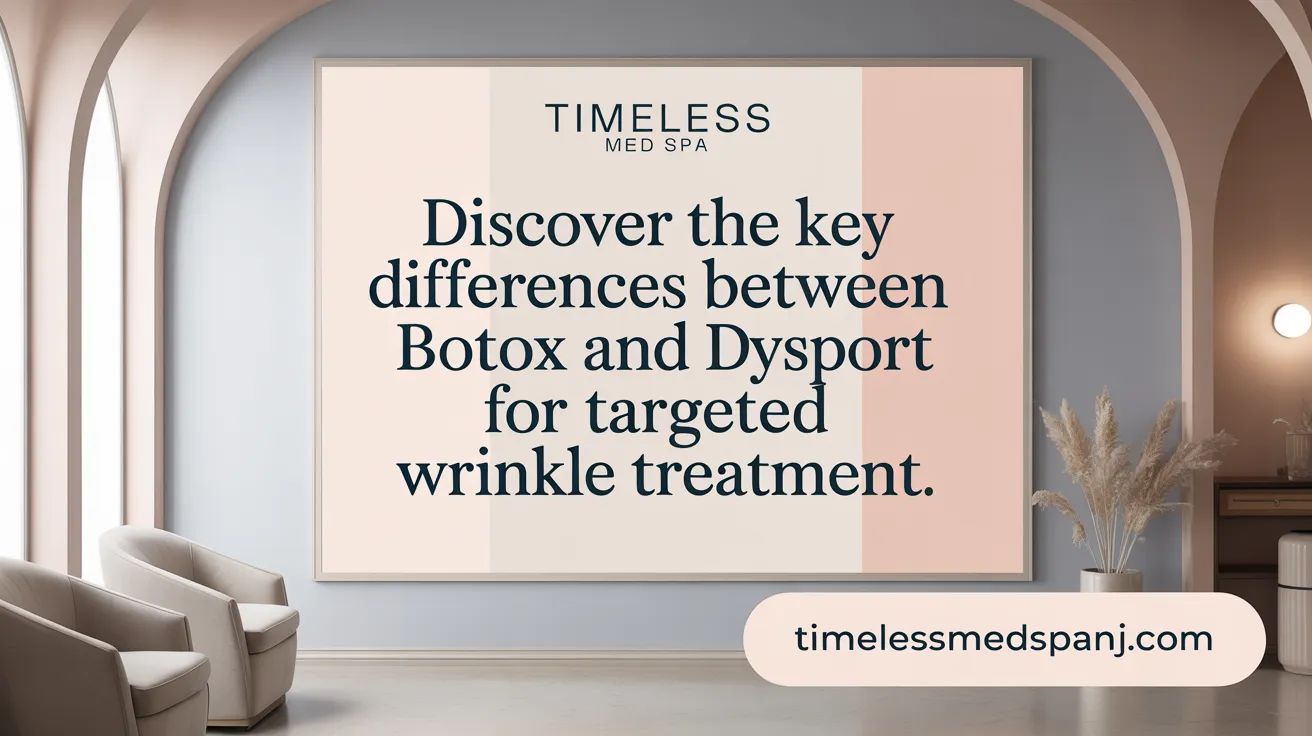The Rising Popularity of Neuromodulators in Modern Cosmetic Care
In the quest for youthful, radiant skin, Botox and Dysport have emerged as two of the most sought-after treatments for wrinkle reduction. Their ability to soften wrinkles and fine lines caused by facial expressions has made them staples in cosmetic dermatology. With millions of injections administered annually worldwide, these neurotoxins have earned their reputation for effectiveness, safety, and convenience, appealing to a diverse range of patients. This article explores why Botox and Dysport have become go-to solutions, examining their benefits, scientific mechanisms, differences, and how they achieve natural-looking results.
Why Botox and Dysport Have Become Popular Solutions for Wrinkle Reduction

Why are Botox and Dysport popular solutions for reducing wrinkles?
Botox and Dysport are widely favored Injectable treatments that work effectively to relax facial muscles responsible for wrinkles caused by facial expressions. Their primary appeal lies in their ability to deliver noticeable improvements quickly, often within just a few days, with results lasting around three to six months.
One of the biggest reasons for their popularity is the minimal downtime involved. The procedures typically take less than 10 minutes, are minimally invasive, and require little to no recovery period. Patients can resume their normal activities immediately after treatment.
Both treatments are FDA-approved and have undergone extensive clinical testing, confirming their safety when administered by trained professionals. Common minor side effects like redness, swelling, or bruising are temporary, and serious adverse effects are rare.
Beyond cosmetic uses, Botox and Dysport also have medical applications such as treating chronic migraines, excessive sweating, muscle spasms, and bruxism. This versatility enhances their appeal, as patients can address multiple concerns with a single treatment.
Furthermore, the treatments are suitable for a broad demographic, including men seeking to maintain a youthful appearance. Their proven effectiveness in reducing expression lines like crow’s feet, forehead lines, and glabellar lines contributes to their consistent popularity.
Overall, the combination of quick results, safety, effectiveness, and additional medical benefits makes Botox and Dysport go-to options for wrinkle reduction and facial rejuvenation.
| Feature | Botox | Dysport | Additional Details |
|---|---|---|---|
| Main Active Ingredient | OnabotulinumtoxinA | AbobotulinumtoxinA | Different formulations, similar mechanism |
| Onset of Results | 3-7 days | 2-4 days | Dysport tends to act faster |
| Duration | 3-6 months | 3-6 months | Regular sessions maintain results |
| Diffusion | Less spreading | Greater spreading | Suitable for targeted vs broader areas |
| FDA Approval | Yes | Yes | For glabellar lines; Dysport also for moderate to severe cases |
| Safety Profile | High | High | Mild side effects, rare serious issues |
| Medical Uses | Migraines, hyperhidrosis | Migraines, hyperhidrosis | Enhances overall treatment value |
| Popularity | Over 7 million annual injections | Increasing popularity, especially among men | Contributes to high patient satisfaction |
This versatility, combined with safety and quick, noticeable outcomes, explains why Botox and Dysport continue to be top choices for facial wrinkle treatments and broader medical indications.
Benefits and Effectiveness of Botox and Dysport in Wrinkle Reduction

What are the benefits and effectiveness of Botox and Dysport?
Botox and Dysport are popular treatments for reducing facial wrinkles caused by muscle movements. They work by temporarily relaxing the muscles that produce dynamic wrinkles — those lines that appear when you make facial expressions like frowning or squinting.
These neurotoxins are highly effective in smoothing out common concern areas such as crow's feet around the eyes, frown lines on the forehead, and glabellar lines between the brows. When administered by trained professionals, both treatments deliver natural-looking results. Patients often note their faces appear refreshed and more youthful without the frozen or stiff appearance sometimes associated with poorly executed procedures.
Results typically start to become visible within a few days after treatment — around 2 days for Dysport and about 4 to 5 days for Botox. Full effects tend to settle in over two weeks, with the wrinkles significantly diminished.
The duration of these effects generally lasts between three to four months, although some individuals might experience longer-lasting results with regular treatments. Dysport tends to diffuse more broadly across the treated area, which can be advantageous for larger zones like the forehead. Botox, with its larger molecules, offers more targeted effects, making it suitable for precise areas.
Both treatments carry a strong safety profile when performed by qualified medical practitioners. Common side effects are mild and temporary, such as redness, swelling, or bruising at the injection site. Serious side effects are rare if proper guidelines are followed.
In summary, Botox and Dysport are highly effective options for those seeking to reduce wrinkles and maintain a youthful appearance. Their quick action, minimal downtime, and proven safety make them attractive choices for facial rejuvenation.
Comparing Botox and Dysport: Differences and Treatment Suitability

What are the differences between Botox and Dysport, and how do these differences affect their suitability for wrinkle treatment?
Botox (onabotulinumtoxinA) and Dysport (abobotulinumtoxinA) are both popular neurotoxins derived from the bacterium Clostridium botulinum, used widely for reducing facial wrinkles. They share the main purpose of relaxing facial muscles to diminish lines caused by expressions, but they differ in their molecular composition, diffusion behavior, onset of action, and dosing ratios.
One of the primary differences lies in their formulation. Botox contains a larger molecule with attached proteins that allow for more precise, targeted effects. Conversely, Dysport has a smaller molecular structure, which enables it to spread more broadly after injection.
This difference in diffusion significantly influences their treatment applications. Dysport’s tendency to diffuse more makes it suitable for larger treatment areas like the forehead, where broad coverage is desired. It begins to show results faster, typically within 2-3 days, making it appealing for patients seeking quick improvements. In comparison, Botox usually takes about 4-5 days to manifest noticeable effects and is preferred for smaller, more targeted areas such as crow’s feet or the area between the eyebrows.
Another consideration is dosage. For equivalent effects, Dysport generally requires approximately 2.5 times more units than Botox. This ratio is important for practitioners to calculate appropriate doses and achieve balanced results.
The duration of effects from both treatments is similar, typically lasting between 3 to 6 months, though some studies suggest Dysport may last slightly longer in certain cases.
In summary, while both Botox and Dysport effectively reduce wrinkles and have similar safety profiles, their differences in formulation, spread, and onset make them better suited for specific areas and treatment goals. Botox offers precise control for small muscle groups, whereas Dysport’s broader diffusion and quick action suit larger areas and rapid results. The choice depends on individual needs, facial anatomy, and the desired outcomes.
The Science Behind Botox and Dysport’s Wrinkle-Reducing Effects

What is the scientific mechanism behind the wrinkle-reducing effects of Botox and Dysport?
Botox and Dysport work by interfering with the communication between nerves and muscles in the face. Both contain botulinum toxin type A, a powerful neurotoxin that targets nerve signals responsible for muscle movement.
When injected into specific facial muscles, these treatments inhibit the release of a neurotransmitter called acetylcholine. Acetylcholine is essential for transmitting nerve instructions to muscles, prompting them to contract.
The toxins bind to special receptors on presynaptic nerve cells. Once attached, they are internalized into the nerve endings. Inside, they cleave a protein called SNAP-25, which plays an important role in the vesicle fusion process that releases acetylcholine. Without this fusion, acetylcholine cannot be released.
This interruption prevents nerve signals from reaching the muscles, leading to temporary paralysis of targeted areas. The muscles relax, which reduces the formation of dynamic wrinkles—those caused by repeated facial movements like frowning, smiling, or squinting.
Results begin to appear within a few days, reaching their peak in about 1-4 weeks. The relaxation effect lasts for approximately three to six months. Over time, nerve endings regenerate and reform new SNAP-25 proteins, which restores muscle activity and facial expressions.
In summary, Botox and Dysport smooth wrinkles by blocking nerve signals, causing muscles to relax, and preventing the repetitive movements that deepen lines over time.
Achieving Natural-Looking Results with Botox and Dysport
 When it comes to wrinkle treatments, achieving natural-looking results is a top priority for many patients. Botox and Dysport are popular options because of how skillfully they can be used to soften lines without creating an expressionless appearance.
When it comes to wrinkle treatments, achieving natural-looking results is a top priority for many patients. Botox and Dysport are popular options because of how skillfully they can be used to soften lines without creating an expressionless appearance.
One important aspect is tailored dosing. Skilled practitioners customize the amount of neurotoxin injected based on each person’s facial anatomy and the severity of their wrinkles. This personalized approach helps in relaxing the right muscles, avoiding excessive paralysis that can hinder natural movement.
Targeted muscle relaxation is another critical factor. Both Botox and Dysport work by selectively targeting specific muscles involved in facial expressions. This precise targeting diminishes the appearance of dynamic lines caused by muscle contractions, such as frown lines or crow’s feet, while still allowing those muscles to move naturally.
Preserving expressions is essential to maintain a person's personality and ability to communicate emotions. When used correctly, these treatments prevent the “frozen” look often feared by patients. The skill of the injector ensures that facial expressions stay natural and that the overall facial harmony is preserved.
Dysport has a slight advantage in diffusion, spreading more evenly over larger areas. This quality can lead to more natural results, particularly for broad treatment zones like the forehead.
Effective treatment planning involves careful assessment of the face, clear goals, and strategic injection points. With proper planning, Botox and Dysport can reduce wrinkles effectively while keeping facial movements expressive.
Ultimately, the secret to natural results with these treatments is a combination of advanced techniques, individualized dosing, and the expertise of a qualified medical professional. This approach allows patients to look refreshed, not overdone.
Additional Insights: Safety, Convenience, and Extended Uses of Botox and Dysport
What is the safety profile and what are the common side effects?
Botox and Dysport are considered safe when administered by trained healthcare professionals. They have extensive clinical testing and a high safety record. The most common temporary side effects include redness, swelling, bruising, and mild discomfort at the injection site. Rarely, more serious effects like eyelid drooping or muscle weakness can occur if not properly administered.
How quick and easy are the treatments?
Both treatments are quick, usually taking less than 30 minutes. They are minimally invasive, involve only a few injections, and do not require anesthesia. After the procedure, most patients can return immediately to normal activities with no downtime needed.
Are there other medical conditions that Botox and Dysport can treat?
Beyond wrinkle reduction, both neuromodulators are approved for medical uses. Botox, the original FDA-approved botulinum toxin, is used to treat hyperhidrosis (excessive sweating), chronic migraines, and bruxism (teeth grinding). Dysport is also used for some similar conditions, benefiting patients with muscle spasms and other therapeutic needs.
Which patients tend to seek these treatments?
People across various age groups seek Botox and Dysport, from those in their late 20s or early 30s aiming for preventative measures to older adults wanting to reduce existing wrinkles. There is rising popularity among men who wish to maintain a youthful, refreshed appearance.
How often should treatments be repeated?
The effects of Botox and Dysport typically last three to six months. Regular maintenance sessions can help prolong results. Some patients experience effects up to six months, especially with consistent treatments, which help reduce the overuse of facial muscles and prevent the formation of new lines.
| Aspect | Botox | Dysport | Additional Details |
|---|---|---|---|
| Onset of results | 3-7 days | 2-4 days | Dysport tends to act faster |
| Duration | 3-6 months | 3-6 months | Regular treatments can extend effects |
| Diffusion | Less spreading | More spreading | Suitable for targeted vs. broader areas |
| Medical uses | Yes | Yes | For migraines, sweating, muscle spasms |
| Safety rating | High | High | Rare serious side effects |
These factors make Botox and Dysport versatile and popular choices for both cosmetic and medical treatments, ensuring safety, convenience, and continued benefits for patients.
Why Botox and Dysport Remain the Preferred Choice for Wrinkle Reduction
Botox and Dysport have rightfully earned their status as leading treatments for wrinkle reduction by offering scientifically proven, effective muscle relaxation that smoothes dynamic wrinkles. Their safety profiles, coupled with minimal invasiveness and quick results, appeal to a broad spectrum of patients seeking natural, youthful appearances without sacrificing facial expression. The nuanced differences between Botox and Dysport allow personalized treatment plans tailored to individual needs and treatment areas. Moreover, their versatility in addressing both cosmetic and medical conditions further cements their prominence in aesthetic medicine. For those considering wrinkle reduction, Botox and Dysport continue to represent trusted, reliable options for achieving refreshed, natural-looking skin.
References
- Dysport vs. Botox: What's Better for Wrinkles?
- Can Starting Botox/Dysport Treatment Early Prevent ...
- Botox vs Dysport: Which Injectable Works Better?
- Discover the Benefits of Botox and Why Dysport is Our Top ...
- Botulinum Toxin (Botox) for Facial Wrinkles
- Why Botox or Dysport Is Everywhere Today - Nova Surgical Art
- Botox Vs Dysport | How They Smooth Wrinkles Differently
- 6 Reasons Why Botox and Dysport Are So Popular
- Dysport vs. Botox: What's Better for Wrinkles?
- Dysport vs Botox: Key Differences and Effectiveness
